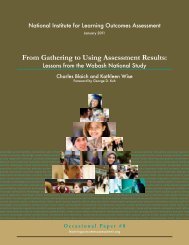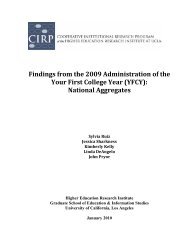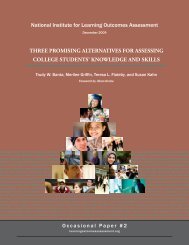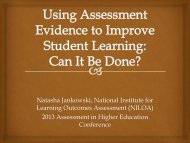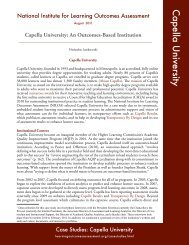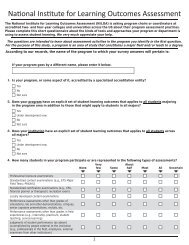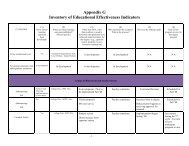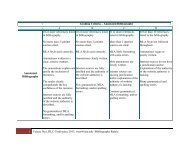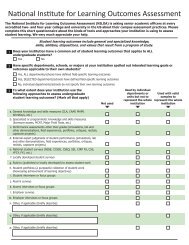Opening Doors to Faculty Involvement in Assessment - National ...
Opening Doors to Faculty Involvement in Assessment - National ...
Opening Doors to Faculty Involvement in Assessment - National ...
You also want an ePaper? Increase the reach of your titles
YUMPU automatically turns print PDFs into web optimized ePapers that Google loves.
With<strong>in</strong> this general phenomenon one also f<strong>in</strong>ds the growth of more<br />
focused communities around specific pedagogies (service learn<strong>in</strong>g,<br />
problem-based learn<strong>in</strong>g, undergraduate research, and so forth) and<br />
the teach<strong>in</strong>g and learn<strong>in</strong>g of particular fields (chemical education, for<br />
example, or the teach<strong>in</strong>g of writ<strong>in</strong>g). As champions of their chosen<br />
approach, these communities have naturally turned <strong>to</strong> assessmentlike<br />
activities for evidence of impact and <strong>to</strong> shape next steps. External<br />
fund<strong>in</strong>g for these efforts has, <strong>in</strong>creas<strong>in</strong>gly, mandated such data gather<strong>in</strong>g,<br />
and the notion that educational reform should be <strong>in</strong>formed by evidence<br />
has become a commonplace—so much so, <strong>in</strong> fact, that talk<strong>in</strong>g about<br />
teach<strong>in</strong>g without <strong>in</strong>vok<strong>in</strong>g learn<strong>in</strong>g has become a sort of anathema.<br />
At the same time, and runn<strong>in</strong>g hand <strong>in</strong> hand with these developments,<br />
has been the rise of the scholarship of teach<strong>in</strong>g and learn<strong>in</strong>g, a movement<br />
that has ga<strong>in</strong>ed significant momentum over the past decade.<br />
Over 250 campuses have been <strong>in</strong>volved <strong>in</strong> the Carnegie Academy for<br />
the Scholarship of Teach<strong>in</strong>g and Learn<strong>in</strong>g (CASTL, runn<strong>in</strong>g from<br />
1998–2009), and many more campuses <strong>in</strong> the U.S. and beyond have<br />
embraced this agenda. Today, grow<strong>in</strong>g numbers of faculty from a full<br />
range of fields and all <strong>in</strong>stitutional types are pos<strong>in</strong>g and <strong>in</strong>vestigat<strong>in</strong>g<br />
questions about their students’ learn<strong>in</strong>g, us<strong>in</strong>g what they discover <strong>to</strong><br />
improve their own classrooms and <strong>to</strong> contribute <strong>to</strong> a body of knowledge<br />
others can build on. Such work has become an entrée for those<br />
who perhaps would not be drawn <strong>to</strong> assessment but feel welcomed by<br />
the idea of see<strong>in</strong>g their teach<strong>in</strong>g and their students’ learn<strong>in</strong>g as sites for<br />
scholarly <strong>in</strong>quiry—particularly <strong>in</strong> a community of like-m<strong>in</strong>ded educa<strong>to</strong>rs<br />
<strong>in</strong>terested <strong>in</strong> learn<strong>in</strong>g from their f<strong>in</strong>d<strong>in</strong>gs. A 2009 survey of CASTL<br />
campuses <strong>in</strong>dicates that such work, even when <strong>in</strong>volv<strong>in</strong>g relatively small<br />
numbers of faculty, br<strong>in</strong>gs energy and openness <strong>to</strong> <strong>in</strong>stitutional assessment<br />
activities:<br />
Today, grow<strong>in</strong>g numbers of faculty<br />
from a full range of fields and all<br />
<strong>in</strong>stitutional types are pos<strong>in</strong>g and<br />
<strong>in</strong>vestigat<strong>in</strong>g questions about their<br />
students’ learn<strong>in</strong>g, us<strong>in</strong>g what<br />
they discover <strong>to</strong> improve their own<br />
classrooms and <strong>to</strong> contribute <strong>to</strong> a<br />
body of knowledge others can build<br />
on.<br />
The scholarship of teach<strong>in</strong>g and learn<strong>in</strong>g is often mentioned<br />
[<strong>in</strong> the Carnegie survey] as hav<strong>in</strong>g had an effect on assessment.<br />
Departments where faculty have been engaged <strong>in</strong> <strong>in</strong>quiry <strong>in</strong><strong>to</strong><br />
the students’ experience understand learn<strong>in</strong>g outcomes better<br />
because “they have assessed student learn<strong>in</strong>g <strong>in</strong> their classrooms,”<br />
and are “noticeably less hostile <strong>to</strong> <strong>in</strong>stitutional assessment.”<br />
Respondents also noted specific programs (the first-year experience,<br />
general education) and majors (biology) where scholarship<br />
of teach<strong>in</strong>g and learn<strong>in</strong>g work has been woven <strong>in</strong><strong>to</strong> assessment<br />
approaches. (Ciccone, Huber, Hutch<strong>in</strong>gs, & Cambridge, 2009,<br />
p. 9)<br />
Clearly there are productive bridge-build<strong>in</strong>g possibilities here, as the<br />
scholarship of teach<strong>in</strong>g and learn<strong>in</strong>g and assessment share overlapp<strong>in</strong>g<br />
agendas, practices, and <strong>in</strong>stitutional constituencies and as grow<strong>in</strong>g<br />
faculty <strong>in</strong>volvement <strong>in</strong> the former shifts understand<strong>in</strong>gs of the latter <strong>to</strong><br />
more clearly align assessment with what faculty actually do as teachers.<br />
Moreover, this k<strong>in</strong>d of serious, <strong>in</strong>tellectual work on teach<strong>in</strong>g and learn<strong>in</strong>g<br />
is mak<strong>in</strong>g its way—albeit slowly—<strong>in</strong><strong>to</strong> campus practices and policies<br />
related <strong>to</strong> faculty roles and rewards. In a 2002 AAHE national survey,<br />
two thirds of chief academic officers reported changes “<strong>to</strong> encourage and<br />
reward a broader def<strong>in</strong>ition of scholarship” (O’Meara, 2005, p. 261). It<br />
is no accident that for more than a decade the assessment conversation<br />
<strong>in</strong> this country ran <strong>in</strong> parallel with an energetic national conversation



